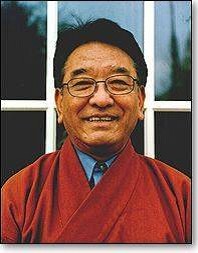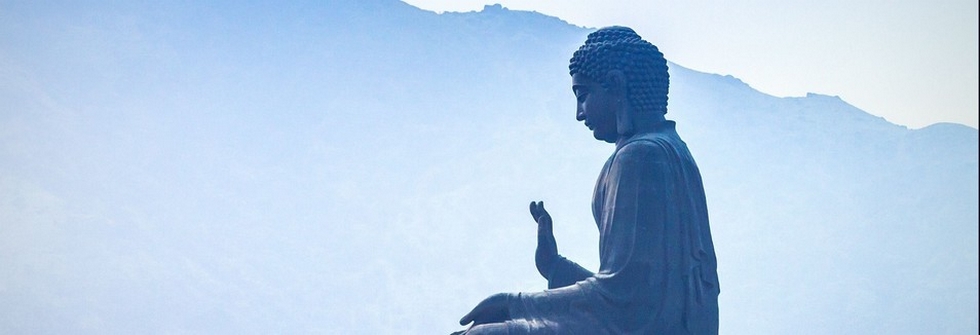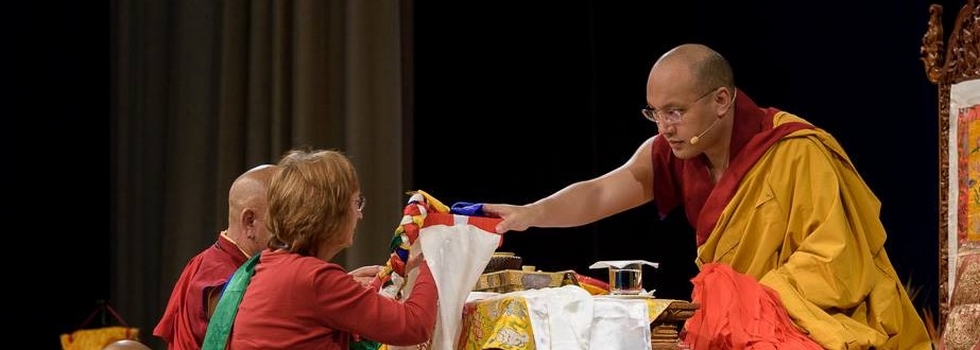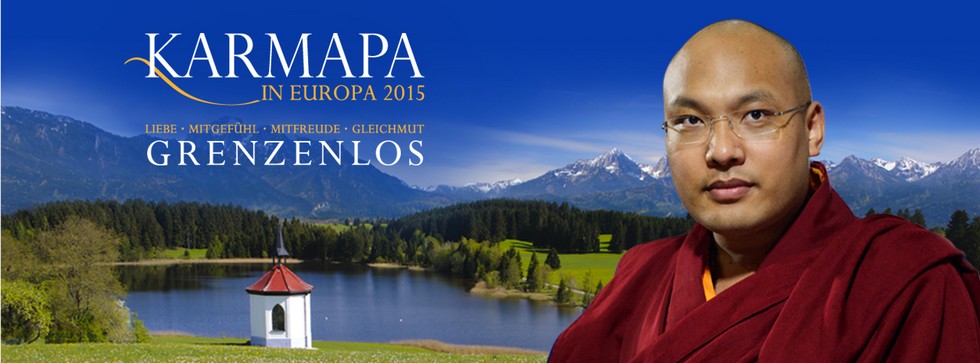
Tarab Tulku Rinpoche, Geshe Lharampa & Dr. phil.
Venerable Tarab Tulku was born in Tibet in 1934. He concluded his studies in Tibetan Philosophy/"Science of Mind" in Tibet with the highest academic degree of a Lharampa Geshe. Rinpoche was Director of Tibet House in New Delhi, India, a lecturer at Copenhagen University for many years, and researcher at the Royal Library of Copenhagen. In order to render ancient Indo-Tibetan knowledge accessible and applicable for modern society, Rinpoche developed a Unity-in-Duality Science of Mind and Phenomena and Personal Development as well as Spiritual and Psychotherapeutic Application. Incorporating all of these subjects, Rinpoche established a four-year education in Unity-in-Duality, which he taught at the Tarab Institutes in several European capitals. For the last 25 years Rinpoche gave lectures at many International Conferences in Buddhist Philosophy/Psychology, as well as Unity-in-Duality workshops around the world tirelessly. Besides various publications in Tibetan language, Rinpoche's English publications include: Catalogue of Tibetan Manuscripts and Xylographs, Vol. I-II, Curzon, Richmond, Surrey Press/Royal Library, Copenhagen 2000; A Brief History of Academic Degrees in Buddhist Philosophy, Nordic Institute of Asian Studies (NIAS), Copenhagen 2000; as well as articles on Tibetan Language and on Buddhist philosophy/psychology which have been published in various international journals. Shortly before his passing in Denmark in 2004, Rinpoche finished a great work in Tibetan on Unity-in-Duality, which will be published in the near future in Dharamsala under the guidance of His Holiness the Dalai Lama.
Unity-in-Duality - The Ground of Everywhere
Knowledge of tendrel (rten- brel being the Tibetan term for the interrelated nature of reality or interdependent origination ) is basic to Buddhist wisdom and dates back to Buddha Shakyamuni. It was always honoured as grounded in the Brahmanic tradition of the 4th century B.C. Records state that the wisdom of India had a noteworthy influence on Greek philosophy in the 3rd century B.C., too. Buddhism was introduced to Tibet in the 7th century A.D., and since then it has been evolving in both theory and practice. From the 11th century onwards there has been an unbroken tradition of empirical inquiry into the nature of reality that is continuing until now. The ancient wisdom of tendrel did not withstand foreign invasions in its homeland but did remain part of the Tibetan culture.
Tendrel is the eminent science of the interrelated nature of everything that exists. In accordance with Buddhist teachings, the laws governing cause-and-effect of existents point to the compounded nature of every phenomenon and to the moment-to-moment change that incessantly takes place in everything and everywhere. Asanga - one of the two most prominent Buddhist philosophers (r. 395-470) - explained the law of the interrelated nature of subject and object precisely and showed that an object does not exist in and by itself, i.e., objects do not exist independently of the experiencing subject for many reasons outlined below, since the base of objects is not different than that of a subject. Nagarjuna - the second most prominent Indian Buddhist scholar (r. 150-250) - elucidated tendrel extensively and showed that both a subject as well as objects only exist conventionally, that neither the one nor the other exists in and of itself, that everything that exists does so in an interrelated way. He also meticulously expounded that conventional realities unfold in four unities: of becoming and ceasing, of finite and infinite, of localization and delocalisation, and of parts and wholes.
The teachings on tendrel are extremely significant for the modern world, which has brought forth a sophisticated materialistic and technological society, achievements that are very beneficial in many ways, but often personal and humane concerns are ignored. In this context, the view and integration of tendrel helps heal many wounds. Unity-in-duality - tendrel - is a major solution to integrate inner wisdom and science, often treated as antagonistic fields. Contemporary researchers have placed most of their attention on outer or materialistic pursuits, which certainly satisfy most of today's needs, yet inner knowledge does not seem to have captured scientists attention when it comes to the humanitarian or social and ecological domains. In Tibet and India, in contrast, realization of tendrel was naturally embedded in investigations of the soft fields of science. It was always and unremittingly a part of philosophy, metaphysics, epistemology, science of the mind, personal and transpersonal investigations and practices; tendrel was the stepping-stone to understand ourselves and the world in our mutual interrelationship; it was the acknowledged ground upon which personal as well as spiritual development was possible. The unity-in-duality paradigm enhances an understanding of the many aspects of the interrelated unities also discovered by modern scientists - it is just as decisive today as it was in the past.1
Buddhism is the study of progressive philosophical views; it emphasises the science of the mind and of phenomena. Buddhists have studied the nature of reality within the spectrum of the mutual correspondence between subject and object. Furthermore, they have always been extremely inquisitive about finding out why our experiences are in discordance with the world and have developed practices that enable us to realize our perceptual and cognitive shortcomings so that we can embrace the world more truthfully. It is my personal conviction that knowledge of tendrel does not depend upon a setting nor that it is restricted to historical times, rather that it is a universal truth and extremely beneficial for anyone aspiring to lead a meaningful life.2
Tendrel with respect to the three unities
of subject/object, body/mind, and energy/matter,
an expression of the unity-in-duality paradigm
In order to make the universal truth of tendrel more accessible and applicable for today's students, I have formulated the truth of tendrel as the paradigm that explains the entwined relationship between the three inter-determinate unities of body and mind, subject and object, as well as energy and matter - interrelationships that pervade and determine everything that exists.
It is a given that a subject's perception and cognition cannot function without the tools it employs, the reason why Buddhist investigation of an object is always carried out in conjunction with understanding the subject; the tools through which it is possible to perceive are also taken into account. Realizing the determining role that the subject plays while perceiving objects through the senses enhances an intensive interest in the subject's components - body and mind. Body in this context refers to the five senses, which are the first five minds that perceive varying sensations and that underlie all mental operations, while imagination and linguistic abilities are features of the sixth mind.
According to Buddhist literature and a yogi's experience of the more subtle levels of perception, the conceptual mind is said to be based on sensory minds and their respective faculties. However, philosophers, mystics, and body/mind researchers have discovered that awareness is inherent to every embodiment, i.e., every living organism is endowed with basic awareness. The physical body consists of matter; awareness is energy, and energy is inherent to both. They tell us that even plants have living energy or basic awareness. Therefore, basic awareness points to a more coarse level of mind. Going deeper, Buddhist scholars found that even inorganic substances consist of both matter and energy, that energy is the very foundation of matter. In this way, understanding matter and energy is the stepping-stone when aspiring to understand the interspersion of subject and object and body and mind. There have been innumerable debates on this topic in the sutras as well as tantras; both approaches engage in study as well as practice.
Subject and object interrelation/unity
We can explain subjects and objects and their interrelated nature in different ways, but we will look at an important distinction between the sensory minds and the conceptual mind presented in the early Abhidharma literature.
Presupposing that human beings possess all favourable conditions that mark a precious human existence, these two functions of the mind are described as distinct and dependent upon objects of perception. The first five minds that perceive a taste, touch, sight, sound, or smell cannot voice what they feel; the sixth mind, the conceptual mind, can. According to Buddhism, the conceptual mind is the most out-spoken because it can apprehend by means of language and therefore it can identify and designate what the senses perceive. It follows that language abilities are based upon sensory perceptions and perceived objects. After identifying an object, the conceptual mind names certain fragments of that object, creating a wholeness-experience, and treats less obvious parts as non-existent; it is the same ability that enables us to compare, measure, analyse, and weigh. Buddhist literature deals with this topic in great detail and teaches that although designations are not inherent to what is perceived, they are the bases for human realities, for grammar and logic, for ideas and ideals, for hopes and fears. The way we see the world depends upon the way we define and classify feelings and sensations, therefore conceptual objects cannot be objective realities, i.e., they cannot be said to exist out there nor in their own right since they depend upon the conceptual mind that identifies, designates, and classifies them.
Next to the neutral realities we create with our conceptual mind and to some extent have in common with others, everyone has his or her own inner world, which is ingrained with personal identity-patterns or habits that have been accumulated through own experiences over a longer and shorter period of time and influence our individual concept of reality. For example, if someone did not feel loved and supported while growing up, that person will automatically perpetuate vulnerable self-referential identity-patterns that strongly influence his or her view of and attitude towards the world and all it entails. As long as private realities are determined and nourished by painful or joyful self-references, they are not objective truths or real in and of themselves; rather they are experienced under the influence of past imprints that are stored within an individual's basic mind. Conceptual reality is the state of identifying and classifying physical sensations and feelings. When considered to be real, the conceptual mind can lift us to a heavenly experience and drop us into a state of paranoia just as fast - everything is possible and coincides with self-referential feelings and thoughts. So, the advantage of being a human being lies in the prevailing relationship between subject and object, which depends upon the underlying patterns in conjunction with the conceptual mind.
In Buddhist literature we read that the first five minds are each related to a specific sensory organ and directly perceive outer objects, that the conceptual mind indirectly takes part. The sensory minds and the respective objects appearing to the five senses are basic to the conceptual mind the moment it seizes a specific perception by defining it. But even at the sensory level, subject and objects are interrelated. Objects perceived by the visual faculty, for instance, do not exist out there exactly the way we see them since sights depend upon our eyes. Also, what we hear depends upon the condition of our ears - had ears developed differently, sounds would be different too. It follows that what we hear does not exist out there in its own right either. The same is true for the other three sensory perceptions. We can look at the interrelationship between subject and object more deeply: If perception and cognition are coarse, so are the experiences of objects, and visa versa, therefore it is conclusive that relying on more subtle tools of perception and cognition renders less diversifying realities and more unifying subject-object experiences.
Body and mind interrelation/unity
Body and mind have always been interrelated, ranging from a coarse level of body and mind, which brings forth a highly dual matrix of existence, to an increasingly subtle level of body and mind, which expresses less diversity.
-- Body and mind interrelationship at a coarse level
General Buddhist literature speaks about a coarse body, telling us that it consists of the five physical senses, and that the five senses have two aspects: the five sensory organs and the five connected energy powers. Each energy power assumes a form, which is situated within or upon the respective sensory organ. These sense powers enable each of the first five minds to perceive an adequate object as it is reflected in or on the respective sensory organ. In reliance upon the specific structure, range and condition of a sensory organ as well as upon the capacity of the connected energy power, the respective mind from among the first five can perceive an object.
Based upon a physical sense organ, its energy-power and an irritation induced by an object appropriate to be perceived, the conceptual mind identifies and classifies a perception. Without the physical senses and the respective minds, the conceptual mind would not function as it does; in that case, negative and positive feelings as well as conflicting emotions would not be, i.e., the coarse mind as well as the variety of exteriorised realities would not evolve without the coarse physical body. In this way, the coarse physical body and the coarse minds are interrelated and determine each other. This interrelationship is quite obvious during the death process, in which case the coarse body weakens; as a result the physical senses and the conceptual mind responsible for thoughts and emotions gradually diminish, too, before ending to function in the process of dying.
Body and mind interrelationship at a subtle level
In the tradition of Buddhist meditation we learn that it is possible for the sixth mind to develop an ability to perceive objects just as directly as the sensory minds do, that it is possible to develop an energy-sensory embodiment (a subtle body) by means of which the sixth mind can directly apperceive shapes and colours, sounds, smells, tastes, and tactile sensations without relying on the perceptual gates of the coarse body. We learn that it is possible for the sixth mind to develop intuitive perception as well as subtle cognition with the help of the subtle body. As it is, though, our physical body is bound by its time and spatial limitations, whereas the dimensions of both open more and more in accordance with the subtlety of the body. It is possible to expand the range of experiences in reliance upon how open the subtle mind has become. For example, in the dream state we naturally use a dream body, which is an immaterial body that can see, hear, smell, taste, and touch. But since the dream body is not impeded by the same boundaries as the physical body, it proves to be an energy or subtle body. Since the dream body can transcend many obstructions presented by time and space limitations, the dream mind can naturally go beyond limitations it is subject to while awake - but only if the dream state has been mastered. I think that this is a main reason why the dream state was practiced in Tibetan shamanistic, tantric and other traditions in many parts of the world - in order to mature spiritually. The subtle body determines the scope of the subtle mind, so both are interrelated.3
-- Body and mind interrelationship at a very subtle level
Tantric literature speaks about rlung-sems, which is a very subtle body/mind energy. rLung refers to the extremely subtle body; sems is the extremely subtle mind inseparably united with rlung. In this case, both subtle body and subtle mind are interrelated to such an extent that they are indivisible, yet distinguishable.
Summary: We saw that the coarse body and coarse minds, the subtle body and subtle minds as well as the very subtle body and very subtle minds are interrelated with each other. The Buddhist tradition tells us that at the very beginning of evolution (evolution being the state of going beyond what was before) the intrinsic, universal mind-energy assumes an immaterial form, leaving the mind ever endowed with an immaterial body and the immaterial body ever endowed with mind. We saw that the physical aspects, which are bound by time and spaces, set the frame for the aspects of the mind. So, eventhough body and mind essentially are inseparable and in unity, at the same time body/mind solidifies to itself along evolutionary lines through progressive stages of coarseness in a mutual interrelationship and functions in dependence upon the itensity and qualities of its dualistic manifestation - unity in duality.
Matter and energy interrelation/unity
Studying the unity of matter and energy renders knowledge of the progressive evolvement of reality and lends insight into the interconnected stages, which each evolutionary phase goes through. Becoming and ceasing - unfolding and enfolding - are like nature's heartbeat and breath: exhalation the exteriorisation and solidification of primordial energy into matter, inhalation the transformation. Both occur in shortest moments of time. Dharmakirti (600 A.D.) spoke about the breath of time in his book Pramana and wrote: …the shortest duration of time is measured on the basis of the disintegration of an atom. 4 It was so early in history that Dharmakirti realized that matter, at its most subtle level, continuously flows and undergoes incessant change. In a late Abhidharma work by Panchen Sönam Dragpa (1478-1555) it is written that evolution begins when element-forces (translated from Tibetan as earth-element original-force, water-element original-force, fire-element original-force , and air-element original-force ) unfold while indivisible with their most subtle energy-form. He taught that when another unit of the four subtle element-forces meet and merge, four new element-forces arise. From there on, more solid structures of matter are born. The first unit of the four element-forces appears before a form arises and is therefore not matter but energy from which matter becomes. The second unit of the element-force is described as a subtle level of matter or energy-in-matter. This is how solid matter - our bodies with the objects appearing to our sensory perceptions - manifests.
According to Buddhist theories of evolution and dissolution, the earth element-source (the most coarse) is the initial force that induces solidification into matter; the water element-source the primordial force of cohesion; the fire element-source the original force for maturation; the air element-source the original force for movement and expansion; the space element-source the potential of the first four; and the mind element-source (the most subtle element) the actual awareness/energy that is basic to both body and mind, to existents as such in the universe as a whole. Organic and inorganic matter throughout space is said to have an awareness-like energy that is basic to every evolvement into ever more concrete spaces. This basic, universal awareness-energy is said to pervade matter most minutely and multifariously, i.e., matter would be a thing-of-not in the absence of this energy. Nothing could become or cease without the unremitting vibrations that turn energy into matter; nothing could abide and nothing could change or progress in its absence.
There is a very interesting passage that clearly describes evolution as the gradual evolvement of energy into matter:
The first stage of evolution is all-ground (kun-gzhi), which has three characteristics: darkness, density, and non-thing-ness. At a certain point the density increases to the extent that vibrations set in. The vibrations become stronger and stronger; then sound arises. Sound grows louder and louder until light rays break forth. Awareness (rig-pa) arises from light, and self-knowing springs forth. At this moment, nirvana (unity) and samsara (duality) split apart. Matter arises from this split. 5
The teachings tell us that our solid bodies and every form of existence evolve from the same basic energy-source that is responsible for the mind, that existence is only possible due to the unremitting saturation of energy in myriad forms. Since the universe is inseparably united with its reverberating energy-source, matter and energy are inseparably one. Therefore, body and mind and subject and object are interrelated and interdependent. So, there is a unifying energy that pervades and moves everything that exists and appears; in a deeper sense, reality is unity within and about its own evolvement into two, unity-in-duality.
The Perspective
Insight into the interrelationships discussed here is a key to benefiting self and others. The interrelations between subject and objects show that our experiences of reality depend upon how we see and particularly experience ourselves. Our feelings and identity of ourselves are our reference-points and therefore the nucleus around which habitual patterns accumulated throughout time either turn and churn or empower us to grow and mature. Change, as we saw, is a feature of every existent in the universe; therefore helpful therapeutic methods should always address the interrelated nature of subject and object, body and mind, as well as that of energy and matter.
The conceptual mind solidifies abstract thoughts and ideas and identifies them as realities. That slight or extended moment blocks the ability to perceive the ongoing process of being and becoming. In other words, when fixated upon and stuck in any conceptual stance, we become imprisoned; as a result we turn angst upon ourselves and scramble to defend a finite nature, in vain, while watching it ebb away, in despair. When less imprisoned in the workings of the conceptual mind, we can open up and reach out to the flowing continuum of being and then experience our infinite nature instead. As long as we lead our lives in dependence upon our senses, our body will frame our mind and world. When we coordinate body and mind more deeply, our mind becomes calm and we experience reality more easefully. When we deepen our subtle body and mind, then we get in touch with and can realize our potentialities that are slumbering within; we can then give life meaning by making friends with ourselves and embracing the world realistically. We saw that energy pervades matter and is its intangible ground, so matter is the bridge to energy-beyond-matter. When we experience the energy that is the innate ground of all, matter loses its solid location and is no longer discordant for us. When we realize the basic nature of matter - the energy-source -, we are no longer divorced from it but inseparably at one and harmoniously abide in delocalised spaces - the ground of everywhere.6 I think that the health, communication and ecological problems we face on a global scale prevail because we do not realize the interrelations I wished to share with you. We deprive ourselves and others when we fail to integrate unity-in-duality, tendrel, in our lives and then - lacking generosity due to clinging to givens we irresistibly take to be real - we lose touch with our deepest heritage and natural home, which is truthfulness. Thank you.
Closing the First Unity-in-Duality Conference, His Holiness the Dalai Lama said:
The view of interconnectedness brings us deeper awareness: Our future depends upon others. Humanity's future depends upon the environment, and our world today is such that all parts of the world are actually one's own part, that is why our future depends much upon others. So in order to seek a happy and successful life for oneself, you have to take care of the interests of others, too. My interest is very much interlinked with others interests; so taking care of others interests is in one's own interest. Taking care of the environment is taking care of our own future. Once we realize the interconnectedness, once we think interdependently, it will bear tremendous benefit.7
Excerpt from the talk presented at the First Unity-in-Duality Conference in Munich, 2002. Following the request of His Holiness the Dalai Lama and Ven. Tarab Tulku, edited by Lene Handberg, director and instructor of the Unity-in-Duality Curriculum held for the Tibetan community in Dehra Dun, India & for Western students in major European cities.
May virtue increase!
This article has been revised and edited with permission and in collaboration with Lene Handberg by Gaby Hollmann, Munich, 2005.
1 See Thrangu Rinpoche, The Twelve Links of Interdependent Origination, Namo Buddha Publ. in Colorado & Zhyisil Chokyi Ghatsal Publ. in Auckland. (Footnote inserted by g.h.)
2 See Khenpo Tsultrim Gyatso Rinpoche, Progressive Stages of Meditation on Emptiness, Zhyisil Chokyi Ghatsal Publ., Auckland, New Zealand. (g.h.)
Direct perception meaning that the senses do not use naming and language (h.l.).
3 See Thrangu Rinpoche, Transcending Ego: Distinguishing Consciousness from Wisdom, and The Five Buddha Families & the Eight Consciousnesses, Namo Buddha Publ. & Zhyisil Chokyi Ghatsal Publ. Also available as a website-download under Thrangu Rinpoche, then Namo Buddha Publications. (g.h.)
4 Dharmakirti, Pramanavarttikam, III, 496. Translated by Leonard Zwilling, Darmakirti on Apoha, Ann Arbor, 1976 (U.M.I. Dissertation Services). (h.l.)
5 Drag-po rang-byung rang-shar gyi rtsa-ba i rgyüd chen-po, in: The Manjurian Prince (17th century text), in the Kheng-ze chin-yang Collection, now part of the Tibetan Collection of the Danish Royal Library in Copenhagen. The original text is a terma which was found by Tertön Rig- dzin-rgöd-kyi-ldem- phru-chen in the 13th century. (h.l.)
6 Ken Wilber poignantly warns: We must honor all levels of consciousness for their intrinsic worth because they are components of our own being, and destroying them is literally suicidal for us. (A Brief History of Everything, Shambhala Publ., Boston & London, 2000.) (g.h.)
7 The book Einheit in Vielfalt ( Unity in Diversity ) contains the speeches from the Munich Conference held in Oct. 2002, in which this quotation is to be found; published by Theseus Verlag (Publishing House), Germany, 2005. (h.l.)















